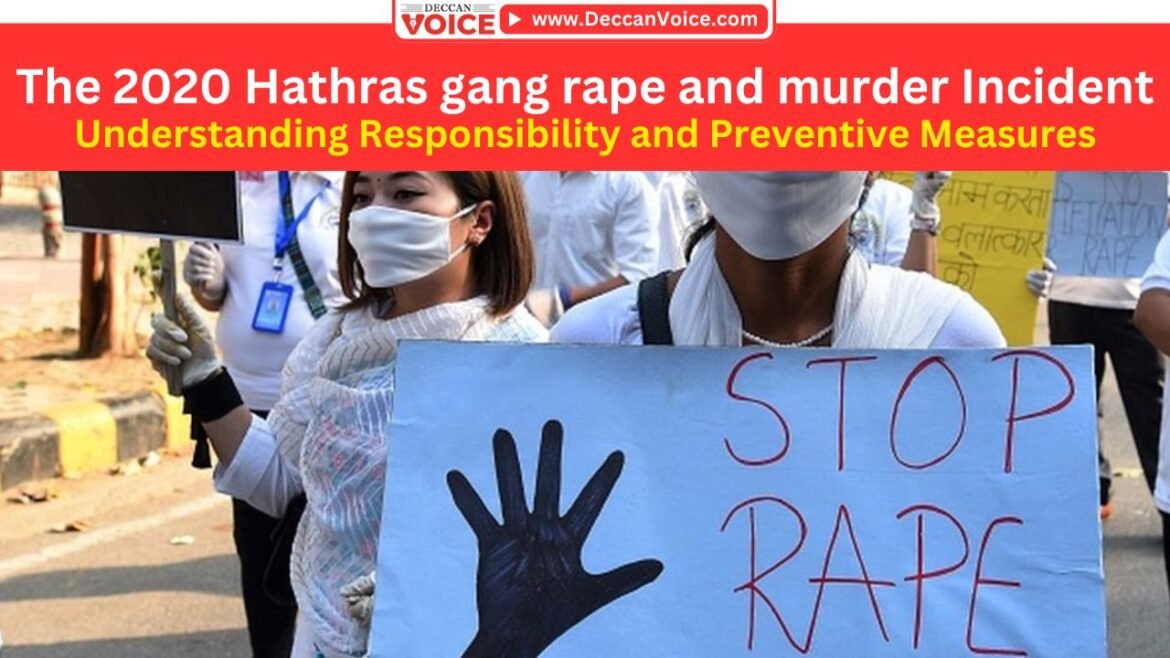Table of Contents
The Hathras incident, a brutal gang rape and subsequent death of a 19-year-old Dalit woman in Uttar Pradesh, India, in September 2020, has brought to light the pervasive issues of caste-based violence, systemic failures in law enforcement, and the need for comprehensive measures to prevent such atrocities. The case not only sparked nationwide outrage and protests but also raised critical questions about accountability and the steps necessary to ensure justice and safety for marginalized communities.
Hathras gang rape and murder Incident
Details of the Crime
On September 14, 2020, a young Dalit woman from Hathras was allegedly gang-raped and severely assaulted by four upper-caste men from her village. 3 accused Ramu Thakur, Lavkush Thakur and Ravi Thakur were released by the court. The victim sustained grievous injuries and succumbed to them on September 29, 2020, in a Delhi hospital. Her death and the nature of the crime led to widespread protests and calls for justice across India source.
Police Response and Public Outcry
The police response to the incident was heavily criticized. Allegations emerged of delays in filing the First Information Report (FIR), insufficient medical care, and attempts to minimize the crime’s severity. The police’s decision to forcibly cremate the victim’s body late at night without the family’s consent further fueled public outrage and suspicions of a cover-up. The family claimed they were locked inside their home and threatened by the District Magistrate (DM) to keep silent about the case. Video footage showed the DM allegedly threatening the family, warning them to “change their statement” or face consequences source.
CBI Investigation
Findings of the CBI
In response to the nationwide outcry, the Central Bureau of Investigation (CBI) took over the case. The CBI’s investigation revealed significant lapses and possible collusion between the local police and the accused. The CBI found evidence suggesting that the police had mishandled the case from the beginning, including tampering with evidence and failing to follow standard procedures for handling such sensitive cases. The investigation also highlighted the pressure exerted on the victim’s family by local authorities source.
Who is Responsible?
Perpetrators
The primary responsibility for this heinous crime lies with the four accused men. Their actions, driven by caste-based prejudices and misogyny, underscore the need to address and dismantle such societal attitudes. The brutality of their crime calls for swift and stringent justice to set a precedent against such acts source.
Law Enforcement
The local police and administration’s mishandling of the case highlights significant systemic failures. The delayed response, lack of proper medical attention, and the controversial cremation of the victim without the family’s consent indicate a serious breach of duty and protocol. Such actions erode public trust in law enforcement and judicial systems, necessitating accountability and reform source.
Government and Legal Systems
The broader legal and governmental systems also share responsibility for failing to protect the victim and ensuring justice. The incident points to the need for stronger legal frameworks, better implementation of existing laws, and more rigorous training for law enforcement officials to handle such sensitive cases appropriately source.
Preventive Measures
Legal Reforms
- Stricter Laws and Enforcement: Strengthening laws against sexual violence and ensuring their stringent enforcement is crucial. Fast-track courts should handle such cases to ensure swift justice.
- Accountability Mechanisms: Establishing mechanisms to hold police and other officials accountable for negligence and misconduct is essential. Independent bodies should oversee investigations to prevent bias and cover-ups source.
Societal Changes
- Education and Awareness: Comprehensive education and awareness programs are needed to change societal attitudes towards caste and gender. Promoting gender sensitivity and respect for all communities can help reduce prejudices.
- Community Support Systems: Establishing support systems for victims of violence, including counseling, legal aid, and medical assistance, can empower victims to come forward and seek justice source.
Institutional Reforms
- Police Training: Regular training programs for police and law enforcement officials on handling cases of sexual violence and dealing with marginalized communities sensitively are critical.
- Judicial Reforms: Judicial reforms to expedite cases of sexual violence and ensure that justice is delivered promptly are necessary. Measures should also be taken to protect the rights and dignity of victims throughout the legal process source.
Conclusion
The Hathras incident serves as a stark reminder of the deep-seated issues of caste-based violence and systemic failures in India. Addressing these challenges requires a multi-faceted approach involving legal, societal, and institutional reforms. Ensuring accountability, promoting education and awareness, and strengthening legal frameworks are essential steps towards preventing such atrocities and ensuring justice for all victims. It is imperative for society, government, and law enforcement agencies to work together to uphold the values of justice, equality, and human dignity.



